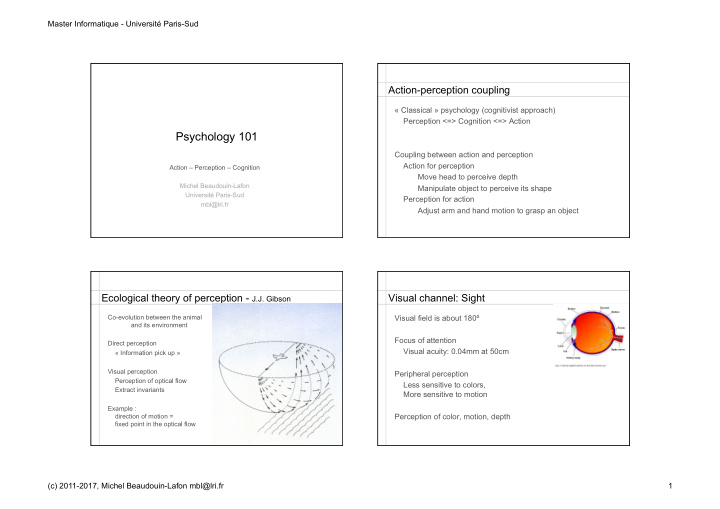



Master Informatique - Université Paris-Sud Action-perception coupling « Classical » psychology (cognitivist approach) Perception <=> Cognition <=> Action Psychology 101 Coupling between action and perception Action for perception Action – Perception – Cognition Move head to perceive depth Michel Beaudouin-Lafon Manipulate object to perceive its shape Université Paris-Sud Perception for action mbl@lri.fr Adjust arm and hand motion to grasp an object Ecological theory of perception - J.J. Gibson Visual channel: Sight Co-evolution between the animal Visual field is about 180º and its environment Focus of attention Direct perception Visual acuity: 0.04mm at 50cm « Information pick up » Visual perception Peripheral perception Perception of optical flow Less sensitive to colors, Extract invariants More sensitive to motion Example : Perception of color, motion, depth direction of motion = fixed point in the optical flow (c) 2011-2017, Michel Beaudouin-Lafon mbl@lri.fr 1
Master Informatique - Université Paris-Sud Held & Hein (1963) Kitten Carousel Depth illusion: Ames room The role of experience in perceptual-motor devlopment Self-produced movement and concurrent visual feedback are essential for the development of visually guided behavior The Monkey Business Illusion Change blindness Watch this video: We do not always notice changes in visual stimuli, even when the change is dramatic https://www.youtube.com/watch?v=IGQmdoK_ZfY Attention is selective: notifications can go unnoticed (c) 2011-2017, Michel Beaudouin-Lafon mbl@lri.fr 2
Master Informatique - Université Paris-Sud Auditory channel: Hearing Auditory illusion: Sheppard-Risset tones Very large sensitivity range A sound that (seems to) always go down Hearing without listening Audio equivalent to Escher ’ s stairs or fountain « Cocktail-party » effect Masking effects Distance between sources Distance between peak frequences Localizing a source Correlation with visual localisation Haptic channel: TPK Haptic channel: TPK T ouch: 6 types of sensors T ouch Hot, Cold, Pain Pressure, Touch (2 sensitivities) P roprioception Configuration of one’s body in space, used to perceive, e.g., the shape of an object (c) 2011-2017, Michel Beaudouin-Lafon mbl@lri.fr 3
Master Informatique - Université Paris-Sud Haptic channel: TPK Vestibular sense T ouch Sense of balance: relative orientation in space P roprioception Located in the inner ear K inesthesia Tension of one’s muscles, Multimodal perception: visual, kinesthetic, vestibular used to assess the weight or resistance of an object Discrepancies cause Motor system Motor system Control body movements Control body movements Locomotion Kinematic chain: articulated arrangement of the limbs Physical action to combine large amplitude and precise movements Gesturing, hand movements Voice (c) 2011-2017, Michel Beaudouin-Lafon mbl@lri.fr 4
Master Informatique - Université Paris-Sud Motor system Motor system Control body movements Control body movements Kinematic chain Kinematic chain Bi-manual control ( Yves Guiard ) Bi-manual control ( Yves Guiard ) Non dominant hand: sets the context Application to a drawing interface: Toolglasses Dominant hand: acts within that context Toolglasses and Magic Lenses, Bier et al., SIGGRAPH 1993 Motor system Functions of the gestural channel (Claude Cadoz) Controlling a gesture: target pointing Epistemic: acquire information Fitts’ law MT = a + b log(1 + D / W ) MT, movement time Ergotic: D , distance to target W , width of target transform through a , b , empirically determined constants physical action Scale invariant: Semiotic: pointing a target twice as large at a distance twice as long emit information takes the same time (c) 2011-2017, Michel Beaudouin-Lafon mbl@lri.fr 5
Master Informatique - Université Paris-Sud Memory and learning Different types of memory Short-term memory Working memory Low capacity (7 ± 2) Short-lived (10-30s) Long-term memory Infinite capacity Unlimited duration Associative access Repetition reinforces memory and learning http://www.human-memory.net/types.html Action theory - Don Norman Plans and Situated Action (Suchman) Goal Humans do not always act according to a pre-made plan Action is situated Intention Evaluation The plan is revised / adapted according to the local situation Evaluation Execution distance distance Spec. actions Interpretation Example: empty printer - add paper - print to another printer Execution Perception - give up printing System (c) 2011-2017, Michel Beaudouin-Lafon mbl@lri.fr 6
Master Informatique - Université Paris-Sud Problem solving Strategies in case of error current state continue undo starting state goal repair expected state Mental models Mental representations that help us reason and solve problems (c) 2011-2017, Michel Beaudouin-Lafon mbl@lri.fr 7
Recommend
More recommend